Some Notes on Stage Combat:
Elizabethans loved martial battles, esp. famous actors recreating famous duels. They loved the spectacle of violence.
The Backsword was 30 inches long with a
wicker basket to protect the hand, made of wood, in which two combatants beat
one another to draw blood. They aimed for the places where bone was just under
the skin—elbows knees, behind the ears, etc.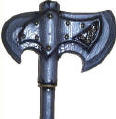
Everyone loved fencing and fighting, from the queen to the lowly apprentice. The right to own and bear arms was long established in England from the early 12th century. People were required to own a weapon according to their position and station in life. Certain kinds of arms were forbidden, and London was very careful about violence getting out of control. Bearing arms had two ramifications: it established the right, and it distinguished rank.
14 years was the minimum time of training to become a Master of Fence. In the trial, the candidate was tested using 7 different weapons; all the masters within 30 miles of London were brought to the site for the test. For period information see DeLacasa, Rich Cabinet... and James Aylwerd, Master of Arms.
Old soldiers returning from combat often taught for a meal, drink, etc. By 1540, Henry VIII gave a patent for the promotion of schools of fence. Roger Ascham said in 1545 that all were learning fence along with their other studies.
Haberdashers sold weapons. England was perpetually under a threat of war and all men had to be ready. England never approached the code duello of Spain or France, though the Italian manners of fence and fighting were becoming ever more popular in England.
London Masters of Fence
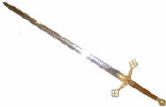 put
on shows in theatres for prizes and drew huge crowds. Sword and Buckler
were more established English weapons, but the London masters were more
frequently teaching rapier and dagger. There's no recorded instance of a
foreign Master playing a prize in a London theatre setting. The Londoners
had a monopoly, apparently; yet there were many foreign Masters operating
schools and giving private lessons.
put
on shows in theatres for prizes and drew huge crowds. Sword and Buckler
were more established English weapons, but the London masters were more
frequently teaching rapier and dagger. There's no recorded instance of a
foreign Master playing a prize in a London theatre setting. The Londoners
had a monopoly, apparently; yet there were many foreign Masters operating
schools and giving private lessons.
Weapons included the staff (6 feet long with tips of bone or metal—Pole Arms are staffs with blades on the end, such as spikes, etc.), the long sword (ridiculed by Shakespeare in Romeo as a weapon of old men, though Masters had to learn it—it was the standard weapon in England for 600 to 700 years; it was a two-handed weapon and could protect the standard bearer), the short sword, rapier, cudgel, dagger, poniard, and bastard sword (which could be used with one or two hands—it would appear in a medieval history play). "Broad Sword" is a modern term; there's no allusion to one in Elizabethan times.
Other than the rapier and dagger, the
single-handed sword was most often used.
 It
was used from the 1300s as a cut and thrust instrument and very popular.
Cunning and training were necessary for its proficiency because one had to
search out the openings (chinks) in the armor.
It
was used from the 1300s as a cut and thrust instrument and very popular.
Cunning and training were necessary for its proficiency because one had to
search out the openings (chinks) in the armor.
The Foil is not the epitome of anything but "foil combat"; it is not the refinement of weaponry. The rapier became refined and more sophisticated, as did other weapons.
The single-handed sword was taught in such a
way to learn how to grapple, to use the hilt, etc. The face, armpits, belly,
groin, or back of the knee were the vulnerable points.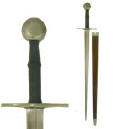
A Target was a shield with a leather strap, often used with a thrust instrument such as a sword.
A Buckler was a round shield—12 to 24 inches—with a handle in the center to be used with a rapier or a sword. The Buckler only had a handle; the Target had a strap and handle.
Patrons loved rapier and dagger. It cost one as much as 100 pounds a year for private instruction. People would also meet in private to learn secret moves, paying perhaps an addition 10 pounds for the privilege.
In using the rapier, one tries to stay back while coming in, using quick footwork and feints. The poetry and skill in the eloquence of the moves was much admired.
At first the short sword and rapier were difficult to tell apart. In the 16th century many of these medieval weapons were becoming transformed into similar type weapons. The short sword is a short, flat, two-edged sword that comes to a point, held by one hand and about 31 inches in length. The rapier was 36 inches to 4 feet in length and gradually became thinner, used for thrusting rather than cutting--but its edges were razor sharp. A Poniard is a French dagger—an offensive weapon that was longer, sharper, and more narrow than the English dagger), which was used with the French rapier.
How were the fights choreographed? No descriptions exist. In very little time, fights would have to be staged in addition to the other stage action. Perhaps prizefights were interspersed in plays as breaks in the action, or preceded or followed the plays. Stage fights probably looked like dramatized prize fights. More than 20 Masters of Fence were teaching in London in Shakespeare's day. Richard Burbage (lead tragedian in Shakespeare’s company, the Chamberlains’/Kings’ Men) may have invited his Master to come into the theatre to help stage the fights on stage, but no evidence exists to support any of these conjectures. It may be safer to assume that the actors choreographed the fights they were involved in, using what they had learned from Masters.
On the stage, a logical sequence of violent
actions that tell a clear story is necessary. The image of the fight is
everything—it must be poetized so as not to appear humorous. All fighting looks
humorous if it were not for the serious intent. Each character would fight in a
particular fashion: combative skills, character, mood, reason, etc., must enter
in. What are the limitations and the skills of those involved? Of the space?
Maximum effect with the minimum of effort is essential.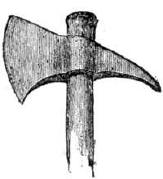
Fighters must go for the vulnerable areas of the opponent and the element of surprise is essential. One must take advantage of space—backing one against a pillar or door, for example, or going for height, such as a table or chair. No one fought on a straight line, but would work for the weak side of the opponent.
To gain an advantage over an opponent, one would
consider time or tempo (each movement has an increment of time), space, and the
physique of the opponent.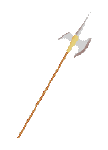
A stock number of moves were probably drawn upon by Burbage, which were then changed by perspective. Sound—groaning, etc.—is equally important for creating an illusion.
Mathematical computations based on size and the lengths of one’s body were diagrammed on the floor by the Spanish for their salons. Five feet was the common length for a rapier.
Short Sword: a cutting weapon; cut and thrust. Rapier: thrusting, primarily; but cutting as well—thrust and cut.
Three different buttons were used on rapiers for training, including bending over the end of the metal, flattening the end like a button, and large golf-ball size coverings in leather.
Passing and blocking actions would often purposely grab the hand or wrist of the opponent, which would then cause the other to move closer and do the same; thus they would disarm one another and switch weapons.
Defense was most often moving forward in
parrying and attacking--not by retreating. See Paradox of Defence, by
George Silver (1599).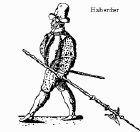
Creating a posture was called a "ward": an opening posture prior to the fight.
The foible of the blade is the thinnest section of the blade, the most likely to break. The forte of the blade is the strongest or thickest section of the blade, the most dependable.
"Punta reverso" is a thrust from the left side (as mentioned in Romeo and Juliet). A "Fleche" (which means "arrow") is a running attack.
The counter response often ended the match—quickly—because one opponent had already committed himself. Some prizefights on stage were very long; but our sense of street fights is that they were short. One avoided first commitment unless he saw something as the two circled one another.
After a thrust, one must use cutting tactics because he's now too close to bring the weapon back—or he grabbed for the wrist or the blade and tried to disarm his opponent.
Measures: Outer (preparation);
Middle (attack: based on foot/weapon distance);
Inner (able to touch the opponent's hand)
"Foyne" means to fence.
The English style uses more cutting styles than does the French.
"Volta secreto" (secret move): taught by masters.
Audiences would yell during prizefights; but no spectator was permitted by law to speak or make a noise during a fencing match.
"Demi-volt": a small turn—response—in which the opponent had to keep his balance.
In Hamlet, the combatants would undoubtedly aim between neck and waist, which would be proper etiquette in a match; but as it continues they go for legs, which would indicate the increased intensity of the fight and its nastiness.
Moves
of the fencer: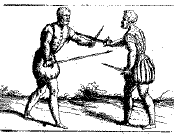
1) Parry one (coming out of the scabbard to block)
2) Parry two (to the outside right)
3) Parry three (above right)
One could strike with the dagger or the pummel; anything counts as a "hit." In Hamlet, however, the private duel rules are for points and the dagger doesn't count as a "point"—only the rapier (check the character Osric for the rules of the match).
By 1623, the nobility dropped the dagger and used on a single weapon in a match.
In staged fighting, the sound should come after the technique, never on for proper effect.
*For this and additional information, one should consult the following: See Combat Mime by Joseph Martinez, and The Swords of Shakespeare.